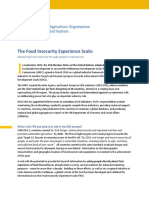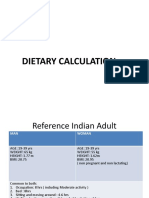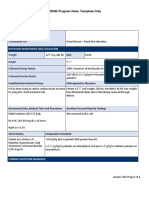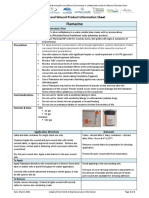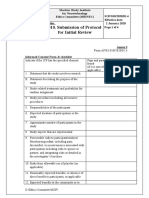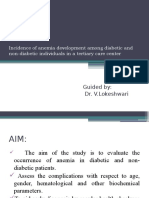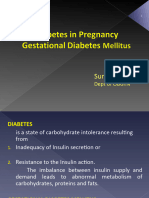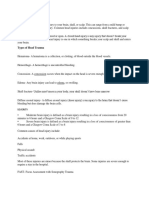chapter 1
Nutrition Screening and Nutrition Assessment
Pamela Charney, PhD, RD, and Mary Marian, MS, RD, CSO
Despite significant advancements made in medical care, theprevalence of malnutrition in hospitalized patients remainshigh, reportedly ranging from 30% to 50%, with a largernumber at risk for becoming malnourished (1–3). It is gen-erally agreed that a percentage of patients in acute, chronic,and alternate-site care settings may have more complica-tions due to their poor nutritional state (1,2). These compli-cations may lead to increased morbidity, mortality, length of stay, and cost of care (4,5). Timely, appropriate nutritionintervention may result in improved outcomes in many caresettings (6–10). Therefore, nutrition screening, the entry tothe Nutrition Care Process (NCP), ensures that patients orclients in a variety of health care settings receive appropri-ate and timely medical nutrition therapy and is a criticalcomponent of quality nutrition care (11).
SCREENING
Overview
Nutrition screening is defined as “the process of identify-ing characteristics known to be associated with nutrition
1
010 c1 (1-19) 6/30/08 3:49 PM Page 1




problems with the purpose of identifying individuals whoare malnourished or at nutritional risk” (11,12). All popu-lations, regardless of setting (acute care, subacute care,long-term care, outpatient, or home) or age, should bescreened to determine the need for nutrition assessment.Screening is considered a supportive system to the Nutri-tion Care Process and Model (NCPM) because the screencan be conducted by individuals other than the registereddietitian (RD) (11).The importance of nutrition screening in the health carearena has been recognized. Patients in both acute and long-term care are at the highest risk of developing nutrientdeficiencies and nutrition-related complications (13).Because nutrient deficiencies or excesses often exist
before
admission (14) and may not be readily apparent(15), screening for nutritional risk in outpatient settings—including the emergency room, ambulatory clinics, andhome care—is important.Each facility or setting is responsible for determiningthe most appropriate mechanism for screening patients orclients. There are very few screens that have been vali-dated (16,17). It is important to evaluate parameters usedfor screening to determine whether the screen is indeedidentifying at-risk patients (Box 1.1).
2
ADA Pocket Guide to Nutrition Assessment
• Height• Weight• Unintentional change inweight• Food allergies• Diet• Laboratory data: albumin,hematocrit (only if labora -tory turnaround time is rapid)• Change in appetite• Nausea/vomiting• Bowel habits• Chewing/swallowing ability• Diagnosis
Box 1.1 Criteria Often Used for Nutrition Screening
010 c1 (1-19) 6/30/08 3:49 PM Page 2
An effective screening process, which can be com-pleted by any qualified health care professional, is:• Simple• Efficient• Quick • Reliable• Inexpensive• Low risk to the individual being screened, and• Has acceptable levels of sensitivity, specificity, andpositive and negative predictive valuesOf the parameters listed in Box 1.1, only unintentionalweight change and decreased appetite/intake have beenvalidated as indicators of nutritional status (16,17). Theuse of laboratory values as a measure of nutritional statusshould be carefully scrutinized, as levels of serum hepaticproteins are indicators of severity of illness and do notreflect nutritional status. Performance of nutritional risk screening programs should be monitored and evaluated atregular intervals in order to determine whether the screenis accurately identifying those patients who require nutri-tion assessment and intervention. Protocols should beestablished in all health care settings to create a time framefor rescreening of those patients who did not require nutri-tion assessment at admission but have an extended lengthof stay. An intervention strategy should also be in place toensure consistent and accurate communication of theresults of the nutritional risk screen to the RD.
Guidelines and Sample Screens
The algorithm in Figure 1.1 (18) was developed by theAmerican Society for Parenteral and Enteral Nutrition(ASPEN) to provide guidelines for adult nutrition screen-ing and assessment.
Nutrition Screening and Nutrition Assessment
3
010 c1 (1-19) 6/30/08 3:49 PM Page 3
4
ADA Pocket Guide to Nutrition Assessment
Nutrition Screen for risk or presence of malnutrition
Acute care: within 24 hours
Long-term care: on admission or within 14 days of admission
Home care: on initial RN visit
Reassessment based on:
change in clinical status
Enteral and Parenteral Nutrition SupportPathways
organizational protocol
Develop Nutrition Care Plan based on:
an interdisciplinary approach
objectives of care, including: immediateand long-term goals of nutrition therapy,educational needs, discharge planning,and/or home training
design of nutrition prescription
Enteral and Parenteral Nutrition SupportPathways
Nutrition Assessment including:
review of nutrition history
evaluation of anthropometric data, bio-chemical indices of nutrition status
review of clinical status
nutritionally focused physical exam
Rescreen at:
regularly specifiedintervals or
when nutritional/ clinical statuschanges
Nutritionally-at-Risk
Adults are considered at nutritional risk if any one of the following is pres-ent:
Actual or potential for developing malnutrition (involuntary loss or gain of > 10% of usual body weight, within 6 months or > 5% of usual body weight in 1 month, or a weight of 20% over or under ideal body weight), presence of chronic disease, or increased metabolic requirements.
Altered diets or diet schedules (receiving total parenteral or enteral nutrition,recent surgery, illness, or trauma).
Inadequate nutrition intake including not receiving food or nutrition products(impaired ability to ingest or absorb food adequately) for > 7 days.
Stable Nutritionally-At-RiskNot-at-RiskAt-Risk
Figure 1.1Adult Nutrition Screening and Assessment Alogrithm
Reprinted from reference 18. A.S.P.E.N. Board of Directors.
Clinical Pathways and Algorithms for Delivery of Parenteral and Enteral Nutrition Support in Adults
. Silver Spring, MD:A.S.P.E.N.; 1998:5, with permission from the American Society for Parenteral and EnteralNutrition (A.S.P.E.N.). A.S.P.E.N. does not endorse the use of this material in any form otherthan its entirety.
010 c1 (1-19) 6/30/08 3:49 PM Page 4






